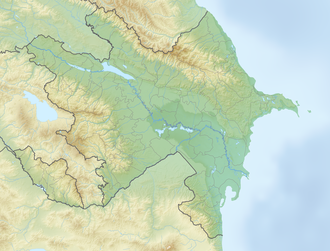Top Qs
Timeline
Chat
Perspective
Binagadi asphalt lake
Cluster of tar pits in urban Baku, Azerbaijan From Wikipedia, the free encyclopedia
Remove ads
The Binagadi asphalt lake (or Binagadi tar pits; Azerbaijani: Binəqədi gölü) are a cluster of tar pits near Binəqədi, Azerbaijan. Asphaltum or tar has seeped up from the ground in this area for tens of thousands of years. The tar is often covered with dust, leaves, or water. Over many centuries, animals that were trapped in the tar were preserved as bones.
This ancient flora and fauna deposit is protected by the State as a monument of a nature of the special significance pursuant to the Decree of the Government of Azerbaijan Republic No. 167 of March 16, 1982.[1]
Remove ads
Geography of the area

The Binagady locality (Binəqədi) is on the crest of a hill 0.5 km (0.31 mi) southeast of the settlement of Binagady, and 7 km (4.3 mi) north of Baku. The coast at its closest is 10 km (6.2 mi) to the south and 25 km (16 mi) to the north.[2]
The bone-bearing area comprises approximately 1.5 hectares (3.7 acres) and is located on a hilltop near the Kyrrar hill. The area is 54–57 metres (177–187 ft) above present sea level, and 48 metres (157 ft) above the level of Lake Boyukshor. An ancient mud volcano (Kichik-Dag) lies north of the fossiliferous area; further to the north is the meridionally elongated, saline Lake Masazyr (Mirdalyabi) and to the northeast Lake Binagady. To the east is the saline depression Kariatakh-Shor, beyond which rises the Balakhany Plateau. Extending from the Binagady hill are oil-bearing Salinas and the saline Lake Beyuk-Shor, which stretches far to the southeast.[2]
Remove ads
Discovery and first excavations
In the 1930s, paleontological excavations and scientific research at this site were conducted by Professor Vladimir Vladimirovich Bogachev.[3]
The excavations continued until 1941 with the participation of Kasabova and Sultanov and were resumed in 1946 under the supervision of Burchak-Abramovich.[2]
Natural-Historical Museum

The Binagadi fauna and flora deposit has been suggested to be richer by number of Quaternary animal fossil than the Californian La Brea Tar Pits.[1] The Binagadi deposit is important in studying the paleobiology of entire Caucasus, Middle East, and the European part of NIS countries.[1]
References
Publications
External links
Wikiwand - on
Seamless Wikipedia browsing. On steroids.
Remove ads




